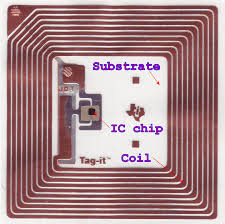 RFID device RFID device
Radio Frequency Identification!
RFID, isn’t that the little chip they put on credit cards these days? Yes but it is more than that. While RFID has been in use since the Second World War, lately it has become much more prevalent. RFID labels are in clothes, toys, military hardware and many of the products you buy. The US DOD and Wal-Mart now requires all their suppliers to enable products to be RFID traceable.
How Does RFID Work?:
RFID is one of a group of technologies called AIDC, (Automatic Identification and Data Capture). They are designed to automatically identify objects, collect data and enter the data into the computer system with little or no human involvement.
This is done by radio. A basic RFID system has three components;
- An RFID tag or Smart Label
- An RFID reader, (an “interrogator”)
- An antenna
The RFID tags contain an integrated circuit. It can be very small and concealable. When it receives the correct radio signal it responds by sending the information it has to the reader as a radio signal. The reader then processes the data it received.
Two Types of RFID:
- Passive – Does not require a power source, (it is powered by the energy of the radio scan). The range is limited but it does not run out of power.
- Active – Does require a power source like a small battery. Has a greater range and can transmit all the time but also has a limited service life.
RFID and Smart Labels:
Smart Labels incorporate both RFID and barcode technologies. An RFID inlay is embedded in an adhesive label with a bar code printed on it. Bar code readers are much more common and easier to program. RFID hardware costs more and requires more programming skill.
Bottom Line:
Anyone with a suitable device can scan the RFID device, and do so covertly. If you have one of those “chips” on your credit card then you might want to consider one of those blocking sleeves or wallets. Google up RFID blocking sleeves and choose from the plethora of available sleeves.
Go back to the top
|